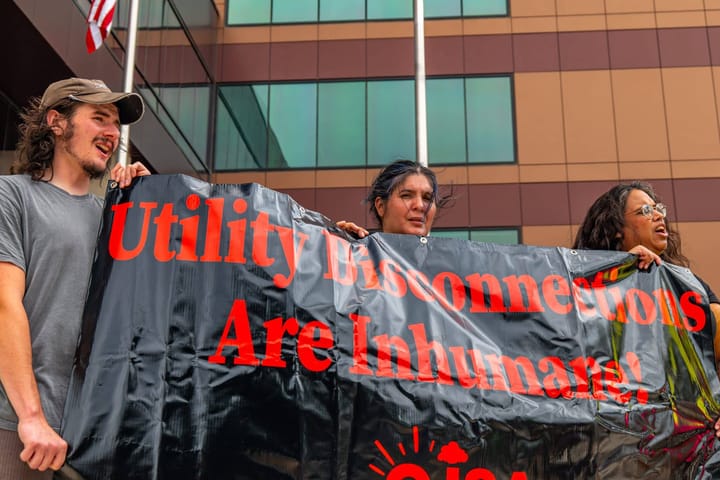In Texas, Bats Are Beloved And In Danger
Though hardy animals, Texas bats are seeing major upheavals to their environment thanks to man-made climate change.

Texas loves its bats. Across the state, there are multiple tourist sites that cater to visitors who want to watch the massive clouds of them emerge from sleep at dusk and hunt insects through the night. Though hardy animals, Texas bats are seeing major upheavals to their environment thanks to man-made climate change.
Hotter Weather Leads to More Overwintering, Which Can Be Fatal
Though Texas is home to 32 species of bats (more than any state in the country), when most people think about bats, they are picturing the Mexican free-tailed bat. Over the summer, tens of millions of them make their home in Texas, particularly in Bracken Cave in the Hill Country. When they fly out of Bracken Cave, they blot out the setting sun as they head off to hunt pests in the farmlands around the area.
Fran Hutchinson, Director of the Bracken Cave Preserve, 65, was a hardcore caver and corporate American cog before retiring to help preserve bats in the state. Typically, the bats arrive at the cave in March and exit around November ahead of the winter. More and more are staying now, no longer feeling the need to flee south to avoid the cold. While that sounds like a positive, it can turn fatal quickly.
“It’s okay until Mother Nature randomly reverts back to the old climate,” he says. “During Winter Storm Uri, we had an extranormal winter. Thousands of bats froze to death. The caves were fine because of the insulation, but the ones sleeping under bridges? They died. Everything is fine if the climate doesn’t change, but that’s what’s happening. You get the new normal, but then all of the sudden you get this cold snap and that catches them off guard.”
As climate change is sometimes referred to as global warming, it may seem strange that it can cause the harsher winters that Texas is seeing. Higher temperatures near the North Pole weaken the polar vortex that keeps the icy winds contained. When the vortex ebbs, blasts of cold air shoot down through the United States, leading to the freeze in 2021 that crippled much of Texas and killed so many of its bats.
Sudden Floods Kill Bat Pups That Sleep Under Bridges
The entire country is watching as Kerr County continues to search for survivors from a catastrophic flash flood earlier this month. The Guadalupe River rose 20 feet in an hour and swept mercilessly through a summer camp, killing more than 100 people.
Despite their ability to fly, bats die by the thousands in major floods. When Houston was hit by Hurricane Harvey in 2017, the large colony under the Waugh Street Bridge suffered major losses. Bats typically need to drop some distance from their roost to begin flight. High waters cuts them off from that space.
Addison Gaines, urban wildlife biologist for Houston on behalf of the Texas Parks and Wildlife Department, wasn’t in the city for that hurricane, but she’s still seen enough in her time to be worried about the flooding affecting the bats.
“If we get in an increase in rainfall, it harms younger bats,” she said during a phone interview. “They just don’t know how to navigate the flood waters like the older bats. Harvey, a lot of them were able to navigate elsewhere, but the younger ones didn’t have the strength or experience.
Heavy rain in swampy Houston or the Hill Country is typical, but climate change is making the rain harder and more unpredictable. Warm air holds onto water vapor more than cool air, fueling extreme downpours like the one seen in Kerr. Hurricanes from the Gulf of Mexico are also much more intense than they were a generation ago thanks to climate change, adding to the rain and flooding crisis in the state. More floods mean more dead bats.
Death of Trees and Pollinators Can Starve Bats
One of the major casualties from climate change in Texas is the loss of trees and other plant life. Between the hurricanes and blistering temperatures, millions of trees die in the state.
Trees are a major habitat for the insects that bats live on. As they fail, the bats run out of food, especially if they stay in Texas longer because of the temperature rise. Houston has spent the last decade desperately trying to outrun the climate crisis by replanting native bayou trees to cool down the surface and replace those lost to disasters, but it’s a Sisyphean task.
The temperatures affect other plants as well. The heat is causing many to bloom out of season, disrupting the natural rhythm and further destabilizing bats’ food supply. Gaines suggests Texans try to replant as many native pollinators as possible as well as look into building bat houses in their backyards to replace lost habitats for the bats, who are essential to protecting many parts of modern life.
“Bats reduce the use of pesticides in the area,” she said. “We also see them eating insects that will eat garden plants and landscaping. Certain species are also pollinators, particularly for cacti and agave. They play a vital role in commercial products that benefit from pollution.
Any more sustainable future will involve a lot of bats, but man-made climate deeply impacts their ability to live in Texas. While not currently endangered, they are definitely in danger as climate change ravages Texas.



Comments ()